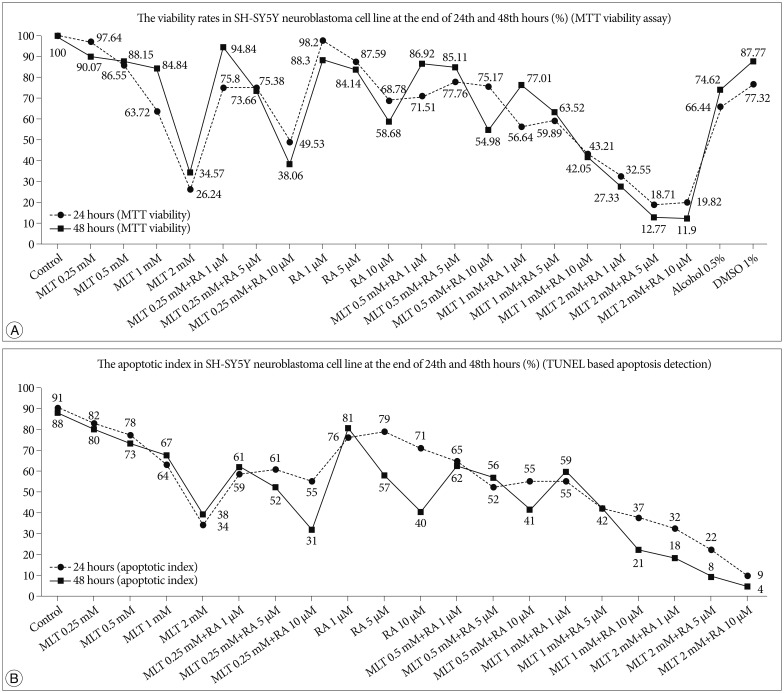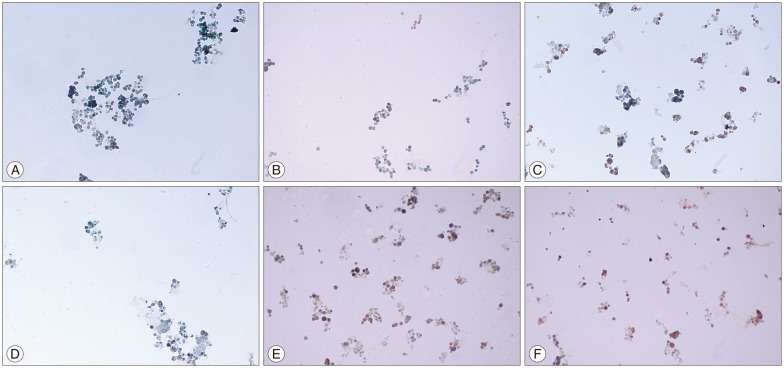J Korean Neurosurg Soc.
2015 Mar;57(3):147-151. 10.3340/jkns.2015.57.3.147.
Comparison of the Effects of 13-cis Retinoic Acid and Melatonin on the Viabilities of SH-SY5Y Neuroblastoma Cell Line
- Affiliations
-
- 1Department of Histology Embryology, Afyon Kocatepe University Medical Faculty, Afyonkarahisar, Turkey. drmtosun@yahoo.com
- 2Department of Molecular Medicine, Dokuz Eylul University Health Sciences Institute, Izmir, Turkey.
- 3Department of Anatomy, Dokuz Eylul University Medical Faculty, Izmir, Turkey.
- 4Department of Neurosurgery, Dokuz Eylul University Medical Faculty, Izmir, Turkey.
- KMID: 2191213
- DOI: http://doi.org/10.3340/jkns.2015.57.3.147
Abstract
OBJECTIVE
Neuroblastoma is one of common childhood tumors. Although its mortality is very high, there is no effective treatment yet. The aim of this project is to evaluate cytotoxic effects of melatonin (MLT) an endogen hormone and 13-cis retinoic acid (13-cis-RA) also named as isotretinoin an analogue of vitamin A on neuroblastoma SH-SY5Y cell line.
METHODS
In this study, SH-SY5Y cell line was used. After cell culture, the cells were exposed to different doses of MLT and 13-cis-RA. 24 and 48 hours later. While the viabilities was estimated with MTT cell viability assay test, apoptotic indexes were calculated after staining with TUNEL based apoptosis kit.
RESULTS
It was observed that MLT has very effective cytotoxic potential than 13-cis-RA on neuroblastoma cell line. At the same time, when MLT and 13-cis-RA were combined, this effect was potentiated. On the other hand, it was found that the effect of 13-cis-RA individually on neuroblastoma cells was very slight.
CONCLUSION
We suggest that in the treatment of patient with neuroblastoma, MLT is very effective and also this effect can be augmented by combination with 13-cis-RA.
MeSH Terms
Figure
Reference
-
1. Benitez-King G, Túnez I, Bellon A, Ortíz GG, Antón-Tay F. Melatonin prevents cytoskeletal alterations and oxidative stress induced by okadaic acid in N1E-115 cells. Exp Neurol. 2003; 182:151–159. PMID: 12821385.
Article2. Chetsawang B, Putthaprasart C, Phansuwan-Pujito P, Govitrapong P. Melatonin protects against hydrogen peroxide-induced cell death signaling in SH-SY5Y cultured cells: involvement of nuclear factor kappa B, Bax and Bcl-2. J Pineal Res. 2006; 41:116–123. PMID: 16879316.
Article3. Choi SI, Joo SS, Yoo YM. Melatonin prevents nitric oxide-induced apoptosis by increasing the interaction between 14-3-3beta and p-Bad in SK-N-MC cells. J Pineal Res. 2008; 44:95–100. PMID: 18078454.4. Dragicevic N, Copes N, O'Neal-Moffitt G, Jin J, Buzzeo R, Mamcarz M, et al. Melatonin treatment restores mitochondrial function in Alzheimer's mice: a mitochondrial protective role of melatonin membrane receptor signaling. J Pineal Res. 2011; 51:75–86. PMID: 21355879.
Article5. García-Santos G, Antolín I, Herrera F, Martín V, Rodriguez-Blanco J, del Pilar Carrera M, et al. Melatonin induces apoptosis in human neuroblastoma cancer cells. J Pineal Res. 2006; 41:130–135. PMID: 16879318.
Article6. Ichimiya S, Nimura Y, Seki N, Ozaki T, Nagase T, Nakagawara A. Downregulation of hASH1 is associated with the retinoic acid-induced differentiation of human neuroblastoma cell lines. Med Pediatr Oncol. 2001; 36:132–134. PMID: 11464865.
Article7. Klongpanichapak S, Phansuwan-Pujito P, Ebadi M, Govitrapong P. Melatonin inhibits amphetamine-induced increase in alpha-synuclein and decrease in phosphorylated tyrosine hydroxylase in SK-N-SH cells. Neurosci Lett. 2008; 436:309–313. PMID: 18406059.
Article8. Klongpanichapak S, Phansuwan-Pujito P, Ebadi M, Govitrapong P. Melatonin protects SK-N-SH neuroblastoma cells from amphetamine-induced neurotoxicity. J Pineal Res. 2007; 43:65–73. PMID: 17614837.
Article9. Lahiri DK, Ghosh C. Interactions between melatonin, reactive oxygen species, and nitric oxide. Ann N Y Acad Sci. 1999; 893:325–330. PMID: 10672259.
Article10. Li SP, Deng YQ, Wang XC, Wang YP, Wang JZ. Melatonin protects SH-SY5Y neuroblastoma cells from calyculin A-induced neurofilament impairment and neurotoxicity. J Pineal Res. 2004; 36:186–191. PMID: 15009509.
Article11. Montilla-López P, Muñoz-Agueda MC, Feijóo López M, Muñoz-Castañeda JR, Bujalance-Arenas I, Túnez-Fiñana I. Comparison of melatonin versus vitamin C on oxidative stress and antioxidant enzyme activity in Alzheimer's disease induced by okadaic acid in neuroblastoma cells. Eur J Pharmacol. 2002; 451:237–243. PMID: 12242084.
Article12. Olivieri G, Hess C, Savaskan E, Ly C, Meier F, Baysang G, et al. Melatonin protects SHSY5Y neuroblastoma cells from cobalt-induced oxidative stress, neurotoxicity and increased beta-amyloid secretion. J Pineal Res. 2001; 31:320–325. PMID: 11703561.
Article13. Ponthan F, Borgström P, Hassan M, Wassberg E, Redfern CP, Kogner P. The vitamin A analogues: 13-cis retinoic acid, 9-cis retinoic acid, and Ro 13-6307 inhibit neuroblastoma tumour growth in vivo. Med Pediatr Oncol. 2001; 36:127–131. PMID: 11464864.
Article14. Romero A, Egea J, García AG, López MG. Synergistic neuroprotective effect of combined low concentrations of galantamine and melatonin against oxidative stress in SH-SY5Y neuroblastoma cells. J Pineal Res. 2010; 49:141–148. PMID: 20536682.
Article15. Sae-Ung K, Uéda K, Govitrapong P, Phansuwan-Pujito P. Melatonin reduces the expression of alpha-synuclein in the dopamine containing neuronal regions of amphetamine-treated postnatal rats. J Pineal Res. 2012; 52:128–137. PMID: 21851386.
Article16. Suresh C, Dennis AO, Heinz J, Vemuri MC, Chetty CS. Melatonin protection against lead-induced changes in human neuroblastoma cell cultures. Int J Toxicol. 2006; 25:459–464. PMID: 17132604.
Article17. Suwanjang W, Phansuwan-Pujito P, Govitrapong P, Chetsawang B. The protective effect of melatonin on methamphetamine-induced calpain-dependent death pathway in human neuroblastoma SH-SY5Y cultured cells. J Pineal Res. 2010; 48:94–101. PMID: 20050990.
Article18. Takada N, Isogai E, Kawamoto T, Nakanishi H, Todo S, Nakagawara A. Retinoic acid-induced apoptosis of the CHP134 neuroblastoma cell line is associated with nuclear accumulation of p53 and is rescued by the GDNF/Ret signal. Med Pediatr Oncol. 2001; 36:122–126. PMID: 11464863.
Article19. Tasset I, Espínola C, Medina FJ, Feijóo M, Ruiz C, Moreno E, et al. Neuroprotective effect of carvedilol and melatonin on 3-nitropropionic acid-induced neurotoxicity in neuroblastoma. J Physiol Biochem. 2009; 65:291–296. PMID: 20119823.
Article20. Wang XC, Zhang YC, Chatterjie N, Grundke-Iqbal I, Iqbal K, Wang JZ. Effect of melatonin and melatonylvalpromide on beta-amyloid and neurofilaments in N2a cells. Neurochem Res. 2008; 33:1138–1144. PMID: 18231852.
Article
- Full Text Links
- Actions
-
Cited
- CITED
-
- Close
- Share
- Similar articles
-
- The Effect of Retinoids in Medulloblastoma Cell Culture
- The Effects of All-trans and 13-cis Retinoic Acid on C6 Cell Line Cultures
- The Effect of All-trans and 13-cis-retinoic Acid in Medulloblastoma and Glioblastoma Cell Culture
- The increased expression of CD99 in a differentiated neuroblastoma cell line
- Effects of REtinoids on Keratinocytes HLA - DR and ICAM - 1 Expression Induced by Interferon - gamma



